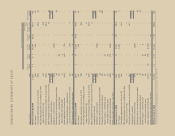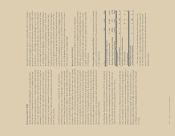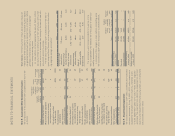Sara Lee 2011 Annual Report Download - page 90
Download and view the complete annual report
Please find page 90 of the 2011 Sara Lee annual report below. You can navigate through the pages in the report by either clicking on the pages listed below, or by using the keyword search tool below to find specific information within the annual report.
NOTES TO FINANCIAL STATEMENTS
Income Taxes As a global commercial enterprise, the corporation’s
tax rate from period to period is affected by many factors. The most
significant of these factors includes changes in tax legislation, the
global mix of earnings, the tax characteristics of the corporation’s
income, the timing and recognition of goodwill impairments, acqui-
sitions and dispositions and the portion of the income of foreign
subsidiaries that is expected to be repatriated to the U.S. and be
taxable. In addition, the corporation’s tax returns are routinely audited
and finalization of issues raised in these audits sometimes affects
the tax provision. It is reasonably possible that tax legislation in the
jurisdictions in which the corporation does business may change in
future periods. While such changes cannot be predicted, if they occur,
the impact on the corporation’s tax assets and obligations will need
to be measured and recognized in the financial statements.
Deferred taxes are recognized for the future tax effects of
temporary differences between financial and income tax reporting
using tax rates for the years in which the differences are expected
to reverse. Federal income taxes are provided on that portion of
the income of foreign subsidiaries that are expected to be remitted
to the U.S. and be taxable.
The management of the corporation periodically estimates the
probable tax obligations of the corporation using historical experience
in tax jurisdictions and informed judgments in accordance with GAAP.
For a tax benefit to be recognized, a tax position must be more-likely-
than-not to be sustained upon examination by the taxing authority.
The corporation adjusts these reserves in light of changing facts and
circumstances; however, due to the complexity of some of these
situations, the ultimate payment may be materially different from
the estimated recorded amounts. Any adjustment to a tax reserve
impacts the corporation’s tax expense in the period in which the
adjustment is made.
Defined Benefit, Postretirement and Life-Insurance Plans
The corporation recognizes the funded status of defined pension
and postretirement plans in the Consolidated Balance Sheet. The
funded status is measured as the difference between the fair market
value of the plan assets and the benefit obligation. The corporation
measures its plan assets and liabilities as of its fiscal year end.
For a defined benefit pension plan, the benefit obligation is the
projected benefit obligation; for any other defined benefit postretire-
ment plan, such as a retiree health care plan, the benefit obligation
is the accumulated postretirement benefit obligation. Any overfunded
status should be recognized as an asset and any underfunded status
should be recognized as a liability. Any transitional asset/(liability),
prior service cost (credit) or actuarial (gain)/loss that has not yet
been recognized as a component of net periodic cost is recognized
in the accumulated other comprehensive income section of the
Consolidated Statements of Equity, net of tax. Accumulated other
comprehensive income will be adjusted as these amounts are
subsequently recognized as a component of net periodic benefit
costs in future periods.
Rates used to discount cash flows are dependent upon interest
rates, market-based risk premium and the cost of capital at a point
in time. Because some of the inherent assumptions and estimates
used in determining the fair value of these reporting units are outside
the control of management, including interest rates, market-based
risk premium, the cost of capital, and tax rates, changes in these
underlying assumptions and our credit rating can also adversely
impact the business units’ fair values. The amount of any impair-
ment is dependent on these factors, which cannot be predicted
with certainty.
Exit and Disposal Activities Exit and disposal activities primarily
consist of various actions to sever employees, exit certain contrac-
tual obligations and dispose of certain assets. Charges are recognized
for these actions at their fair value in the period in which the liabil-
ity is incurred. Adjustments to previously recorded charges resulting
from a change in estimated liability are recognized in the period in
which the change is identified. Our methodology used to record
these charges is described below.
Severance
Severance actions initiated by the corporation are
generally covered under previously communicated benefit arrange-
ments under GAAP, which provides for termination benefits in the
event that an employee is involuntarily terminated. Liabilities are
recorded under these arrangements when it is probable that
employees will be entitled to benefits and the amount can be rea-
sonably estimated. This generally occurs when management with
the appropriate level of authority approves an action to terminate
employees who have been identified and targeted for termination
within one year.
Noncancelable Lease and Contractual Obligations
Liabilities are
incurred for noncancelable lease and other contractual obligations
when the corporation terminates the contract in accordance with
contract terms or when the corporation ceases using the right con-
veyed by the contract or exits the leased space. The charge for these
items is determined based on the fair value of remaining lease
rentals reduced by the fair value of estimated sublease rentals that
could reasonably be obtained for the property, estimated using an
expected present value technique.
Other
For other costs associated with exit and disposal activities,
a charge is recognized at its fair value in the period in which the
liability is incurred, estimated using an expected present value
technique, generally when the services are rendered.
Stock-Based Compensation The corporation recognizes the cost
of employee services received in exchange for awards of equity
instruments based upon the grant date fair value of those awards.
























